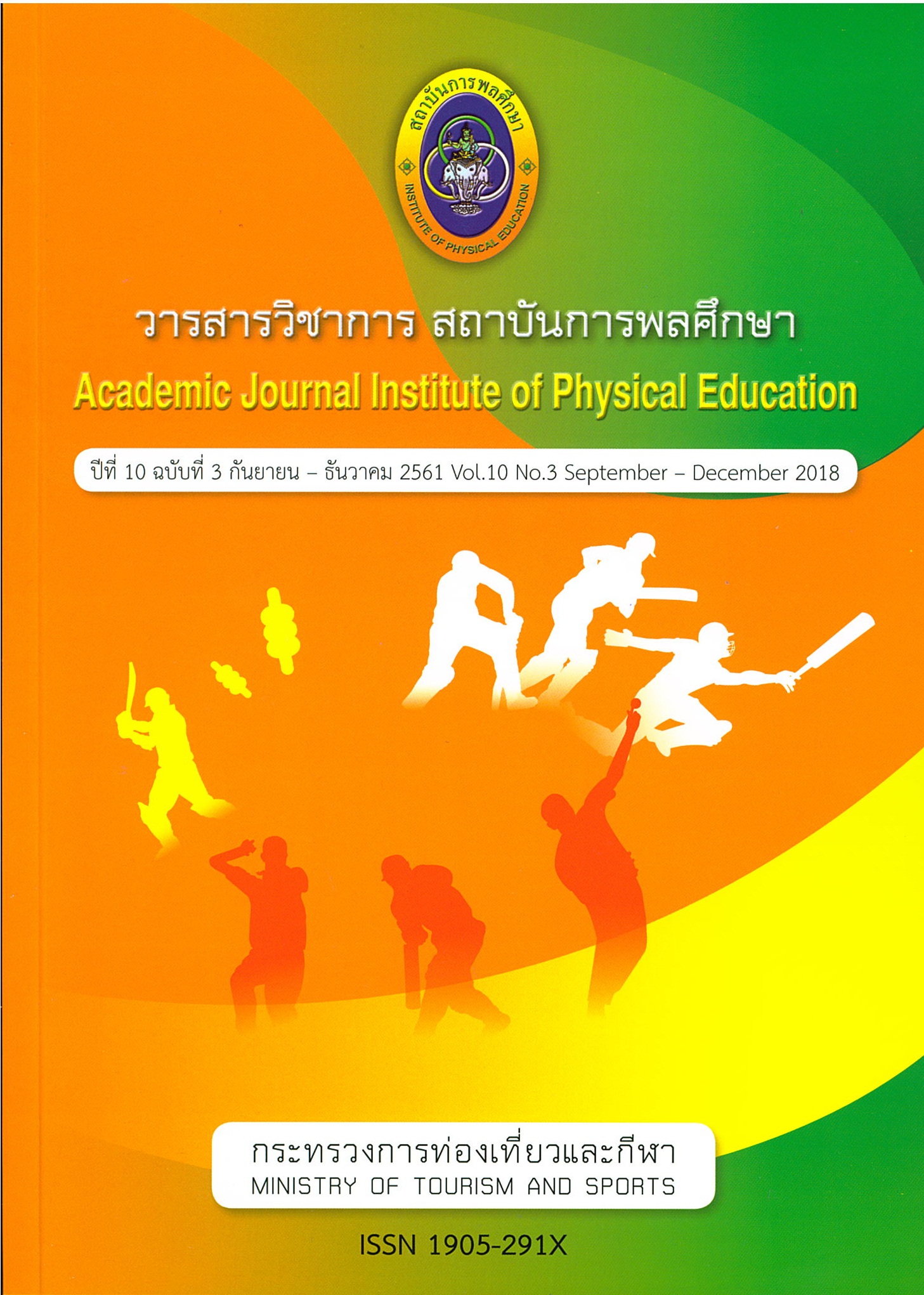The Consequence of Core Muscle Body Strengthening That Impacts the Speed of Freestyle Stroke
Main Article Content
Abstract
The research aims to study the consequence of core muscle body strengthening that impacts the speed of freestyle stroke. The sample of the research is a group of 30 young swimmers at the age of 13-15 from Institute of Physical Education Trang that are selected by using purposive sampling and has competed for the Association’s competition. Use the sample to test the speed of swimming 50 meters freestyle then, take the record of the swimmer to order from 1 to 30, after that arrange the group randomly between who are skillfully and not skillfully to make 3 groups of the sample of 10 people for each group by applying Stratified Sampling. The first group uses Swiss ball for strength training, the second group do floor exercise for strength training and the
last group (Group contro) has normal swim training for 12 weeks then, find mean and standard deviation to analyze variance and experimental model. In addition, to repeated measure in two-dimensional for evaluating the interaction effects between training methodsand training duration byusingtwo-wayanalysisofvariance withrepeated statistics, to analyze the analysis of uncertainty in one way by applying F-test one-way analysis of variance: ANOVA statistics and finally is to analyze One-Way ANOVA With Repeated Measure using Turkey method to test statistical significance of 0.05 level.
The experiment found that: After experimenting for 4, 8 and 12 weeks: groups of the sample has the speed and acceleration of swimming 50 meters freestyle not differently in the statistical significance of 0.05 level. If swimmers want to improve their skill of swimming, they should practice swimming along with practice core muscle body strengthening. However, to practice only body balancing may not enough since not only strong core muscle is important for swimmers in order to reduce water resistance but also other parts of body muscle including arms and legs are important to swimmers. They should practice the stability of their torso along with other parts of the body. Therefore, to practice the core muscle body strengthening is necessary for swimming by increasing intensity that includes the muscular endurance which is the main fundamental for swimmers at the age of 13-15 for good continuity of swimming speed using and movement controlling for every distance.
Article Details
The published article is a copyright of the Academic Journal of Thailand National Sports University. The passage appeared in each article in this academic journal is a perspective of each author which is not related to the journal. Each author is required to be responsible for all components of his/her own article. If there are any mistakes, each author must be responsible for those mistakes on his/her own.
References
กองวิชาการ การกีฬาแห่งประเทศไทย. 2551. คู่มือการฝึกสอนกีฬาว่ายน้ำ. กรุงเทพฯ. ฝ่ายสารสนเทศ การกีฬาแห่งประเทศไทย.
เจริญ กระบวนรัตน์. (2548). หลักการและเทคนิคการฝึกกรีฑา. กรุงเทพฯ. สำนักพิมพ์มหาวิทยาลัยเกษตรศาสตร์.
ชาญยุทธ์ อินทร์แก้ว. (2544). การเพิ่มความแข็งแรงของกล้ามเนื้อขาร่วมกับโปรแกรมการฝึกว่ายน้ำที่มีต่อความเร็วของการว่ายน้ำแบบวัดวาระยะทาง 50 เมตร.วิทยาศาสตรมหาบัณฑิต. บัณฑิตวิทยาลัย มหาวิทยาลัย
เชียงใหม่
ชูมาน เสริมไสย. (2549). หุ่นสวยด้วย Exercise ball, กรุงเทพฯ: สำนักพิมพ์ใกล้หมอ.
สนธยา สีละมาด และดุจเดือน สีละมาด. (2551). การฝึกด้วยน้ำหนักการประยุกต์กายวิภาคศาสตร์และสรีรวิทยาสู่เทคนิคการปฏิบัติ. กรุงเทพฯ: สำนักพิมพ์แห่งจุฬาลงกรณ์วิทยาลัย.
ศิริพรรณ หน่อไชย. (2549). ผลของการฝึกความแข็งแรงกล้ามเนื้อลำตัวบนพื้นและบนลูกบอลออกกำลังกายต่อความแข็งแรงของกล้ามเนื้อท้องและความคล่องแคล่วว่องไวในนักเรียนชั้นประถมศึกษาปีที่ 1. วิทยานิพนธ์. กรุงเทพฯ: บัณฑิตวิทยาลัยมหาวิทยาลัยเกษตรศาสตร์. ถ่ายเอกสาร.
ศุกล อริยสัจสี่สกุล. (2556). ว่ายน้ำกีฬาเพื่อทุกคน. กรุงเทพฯ. สำนักพิมพ์แห่งจุฬาลงกรณ์วิทยาลัย.
Goodman P. (2003). NCSA’s Performance Training. Journal. www.nsca-lift.org/perform,
Lehman GJ, Macmillan B, Macintyre I, Chivers M and Fluter M. (2006). Shoulder muscle EMG activity during push up variations on and off a Swiss ball. [Online]. Available www.pubmed.gov
MarshallPW, MurphyBA. (2007). Increased deltoid and abdominal muscle activity during Swiss ball bench press. [Online]. Available www.pubmed.gov
Mori A. (2006). Electromyography activity of selected trunk muscles during stabilization exercises using a gym ball. [Online]. Available www.pubmed.gov
Paul Delia. (2006). The Swiss ball an introduction to increasing core strength. [Online]. Available http://ast-ss.com/articles/article.asp?AID=35


